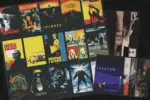Self-awareness has always infiltrated art to some degree. Whether it be conscious or subconscious, intentional or unintentional, the artist knows that the work they create is fiction and that it acts as a mirror reflecting an element of their real life.
But the concept of metafiction, a story that actively flaunts its own literary nature and references its existence within the confines of a story, has exploded in popularity over the past few decades.
These stories take self-awareness to a new level, not just portraying an element of the real world but openly acknowledging their own purpose as lenses to examine it. Often, the stories contain references to the rhetoric and techniques that make up their own writing, referring to the narrator or the figurative language used to enliven its characters.
An older, well-known example of this style of writing is Douglas Adams’s 1979 “Hitchhiker’s Guide to the Galaxy” series. If you have any experience with these books, you know that they tend to tangent away from the world of their sci-fi plot to discuss elements of the story from a far-away lens. There are whole chapters that exist as asides from the main characters, with the narrator talking directly to the reader about some element of the story in a tongue-in-cheek manner. The narrator acts less like a part of the story at times and more like an observer reacting to fiction, thus taking the audience out of the world for a moment and making us painfully aware of its nature as a story.
An example I’m personally more familiar with is Lemony Snicket’s “A Series of Unfortunate Events.” This book series constantly acknowledges its own nature as a story, with the narrator (a fictional version of Snicket that exists within the world of the story) mentioning writing techniques like repetition, allegory, and deus ex machina as they appear in the plot.
Even the title of the series is a sort of ironic use of metafiction, as it literally describes the plot structure that the books follow. Snicket asked his readers to buy into the idea that the story being told to us exists as a narrative within the larger framework of his fictional self’s investigation of a mystery. And along the way, his references to writing techniques can serve as educational tools for aspiring young writers, which they learn to use as they are exemplified in the books.
To put forward one more example, the character of Deadpool often exists within a sort of comic metafiction. The character came to life in the 90s as a Marvel antihero who cannot die, primarily recognized for his tendency to break the fourth wall. He addresses the reader, speaks about his life as if he knows it is a comic, and even plays around with the visual structure of comics in a way that breaks the reality of his fictional universe. This, too, can act as inspiration for writers, as seeing Deadpool speak cynically about the fictional world around him points out the various methods comic writers choose to construct their narratives.
Across all three of these stories, there are opportunities for writers to learn more about their craft. I know I did; reading these stories as a child conditioned me to constantly watch for certain storytelling techniques and better understand how to implement them in my own work. While these stories follow their own characters and plots, they are also, at least to some degree, about the writing process itself.
But there’s another element that connects these three disparate works, and many other stories that deal with metafiction. A certain cynicism or nihilist tone pervades the words of each narrator. Think of Deadpool, for instance. He is a comedic character, often cracking jokes or making snarky comments. But he also kills people a lot. And he’s awfully flippant when he does so.
Deadpool knows his life is fiction, that it “doesn’t really matter” what he does because, to a certain extent, none of it is real to him. He can act without fear of moral repercussions because he is aware of the unreality of his own actions and the lack of control he has as a character in a story someone else is writing. When you look past his jovial demeanor and funny lines, it actually makes him a pretty depressing character.
As for the other two stories I mentioned, they might not go as far as Deadpool often does, but they still contain cynical feelings in their world view. Often, their characters will face cruel or ironic fates which their narrators regard in a somewhat removed manner.
While I love both series I referenced, there’s something unnerving about them when you read them, the same feeling I get in a wax museum or around animatronics. They are painfully aware of their own lack of reality, and they know you are, too, so they play into it as a strength. And it works in these cases, but there are so many metafictional stories that can become creepy, uncanny and sometimes downright sadistic if the writer isn’t careful.
I think the prevalence of stories like that in our current century makes sense. As a society we are plagued by cynicism, and as a generation we tend to rely on irony to avoid facing difficult realities.
Metafictional works are a writer’s reaction to that reality, and while they can provide education and inspiration for young storytellers, they can also act as a grim reminder of our struggles to accept our current moment.
















